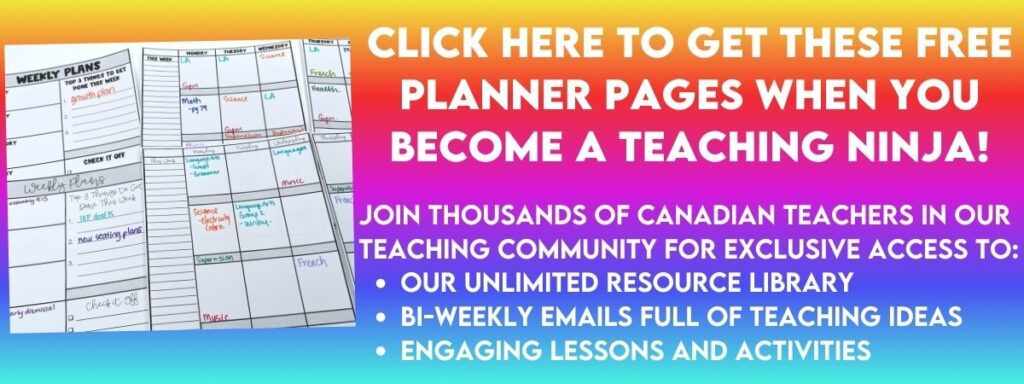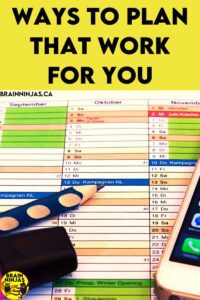
You’ve seen those beautiful planners all over Pinterest and on everyone’s social media. They are masterpieces that we wish could emulate, but alas, us ninjas have a lot going on and so our plan books have been an evolution. We realized early on that our plans aren’t pretty and we needed a way to share a classroom and thus, share our plans with each other.
Finding the planning style for you takes time. Here are some of our best tips for figuring out your planning style.
Think About What You Want vs. What You Need to Plan a Lesson
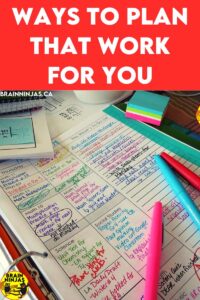
We want to be clear about something. Our lesson plans are not the college or university assignments that take days to write or read, but each lesson follows that format.
We just don’t need to write every single moment of every single lesson down…anymore. Even though it was a lot of work, going through the process for every lesson in every subject was very helpful in creating well-rounded lessons.
In fact, we use these lesson formats in all the lessons we sell because they are effective-even if there are a LOT of words.
So, we have a few different types of planning that we do.
Year Plans
This is basically an outline of our entire school year. We use a spreadsheet and outline each subject area and each month in very general terms. For example it might say for September through November we’re focusing on Number Operations in math. It’s very general, but gives us a timeline for the year. Some people might refer to this as a timeline or pacing guide.
Unit Plans
This is an outline of everything we’ll do in a specific unit. We start with a list of things students will need to be able to do, understand or explain. Then we outline the things we will do to get our students where they need to be, materials we’ll need, ways we’ll teach it and a general list of things we’ll do.
Lesson Plans
This is the daily breakdown of everything we’ll do for every single lesson. We address specific things we’ll do to support students, the order we’ll teach everything, exact tools we’ll use.
If you are looking to differentiate for your students, you might want to check out this post called How to Differentiate Your Instruction.
So, What Goes in Our Plan Book?
We keep a copy of our year plans and lesson plans nearby all the time. This helps keep us on track. Our lesson plans have been significantly shortened to a list of things we’re doing. This might be a page number, reference to an activity or reference to a link on our computer (because we keep a lot of things in files that are well-labeled on our computers).
We also keep a list of school events, classroom events and things that need to get done now, soon or later. Using a simple N, S or L next to things as we write them down helps keep us on track.
Sometimes we write things on sticky notes and then just stick them to the pages until we can write the information in the right place. We make a little time at the end of every day to take care of this task.
What Should You Be Thinking About When Deciding on a Planner?
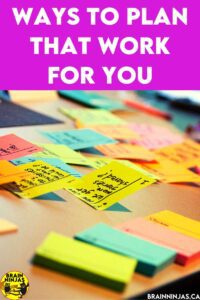
District or School Planning Requirements
Sometimes the thinking is done for you because your district or school has specific rules about how plans are to be done. If this is the case, sorry, we don’t have a solution (but when us ninjas win the lottery and start our charter school, you can come work with us).
If your district or school requires a specific format, the chances are there is a template you can use. Save this template to every device you own so that you can plan lessons anywhere. Copy and paste as much as you can to save yourself time.
Subject areas vs. Bell Schedule
Depending on the amount of flexibility you have in making your own schedule, your planner might need a few blocks to write in or a complicated break down of each lesson.
If you like to have a lot of flexibility in your day where you can move subject areas around, you might need a tool that can help you do that and still keep track of your day.
So, when choosing a planner do you want to have times already inserted or not? Do you want dates and times already included or not?
Techy vs. Low-Techy
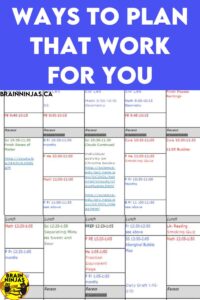
Your comfort level with technology can help you or hinder you. There are many apps out there to help schedule your day, but sometimes a simple paper copy is all you need.
Spoiler Alert-the low tech option is paper.
We’ve played with a lot of different productivity apps over the years. Some are helpful, some are fun and some are just apps.
- trello.com This is good if you share a classroom with someone because we can share boards with each other. It’s not a very linear format, but you can move things around as needed. And it’s FREE.
- airtable.com We’ve played with this one and while it is bright and colourful, we stopped using it since we weren’t diligent enough about updating our information as we went
- evernote.com We paid for this for a year while we used it. It was helpful to both because able to login and use the information, but the same could be done with Google Suite tools now.
- Google Tools: a basic table in a Google Doc or a Google Sheet can be a very effective way to write your plans and you can share them easily with others by letting them view or edit.
- Google Keep is a free Google Suite tool that also has an app. You can make lists and personalize them.
- Planbook.com is a paid planning program for teachers. The friends we know that use it love it, but we also know lots of people that said it wasn’t worth the money. This one requires you to know and use tech effortlessly or it isn’t worth your money.
Size Matters
Do your plans travel with you to and from school? If you’re like us ninjas, you like to take your plan book for a drive home every evening, let in hang out in your front entrance way and then drive it back to school. Maybe something small or online would suit you better.
Planners can be as large as a binder and as small as a wallet. The choices are endless. And if you use a digital format, maybe they’re the size of your phone.
Think about how much you want to lug your planner around. If you don’t take it for long walks or drives, you can probably handle a larger one. If it has to be at your side every moment of every day-go smaller.
Pretty or Simple?
One of the ninjas uses a plain old binder with simple paper pages printed out. It’s not fancy by any means, but it works. This type of planbook works well for those teachers who need a simple paper-pencil option.
You can get a few sample pages from this planner book by signing up for our email list or by checking the Resource Library. The pages are not fancy, but if paper pencil is your groove (or if you still don’t know) this is a great way to save a little money until you know exactly what you want.
If you like decorative tape, fancy pens and stickers then you should use a paper book. If you like colour coding and fancy fonts you should find an online planner.
Up or Across?
This seems like such a silly thing to think about, but it actually matters. Some people like to plan across a page horizontally and others (like ninjas) prefer to plan vertically. Others like to see the whole week or month at a time. Some people can only plan one day at a time.
This is why store-bought planners can be challenging. If you like the cover of one you will likely not like the layout inside or vice versa.
We have bought many different types of planners over the years.
The Happy Planner is a similar system but it is slightly less expensive and is available at Michael’s Stores across Canada. If you really like the system, you can buy a hole punch so add any page to your planner. This can be very helpful for all those papers you receive at school. They also come in lots of sizes so you can customize your planner (or planners if you use them for different aspects of your life).
We haven’t had the pleasure of trying out Bryce’s planners from The Teaching Texan, but we hear so many good things, that we couldn’t leave it off our list. You should check out the site if you like bright, colourful and durable planners. There are lots of choices. They are reasonably priced and sometimes you can get a great sale or coupon deal.
Our current planners are an appointment book from Staples (nothing fancy but it has koalas on it). The other planner is a Happy Planner with vertical days and no times written in. It allows for lots of room to write in things as needed and to add stickers (because that’s really the only reason to have a planner). Haha!
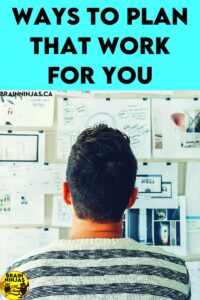
So, finding your planning style takes time. If you like decorating it-go for it. Most of all remember that sometimes plans change and classrooms get messy. Our plan book may not be one of the beautiful ones we love to repin on Pinterest, but it fits with our teaching style.
What’s your planning style? If you don’t quite have it figured out yet, that’s pretty normal. We’ve switched from one way to another over the years and we’ve tried lots of different ways to figure out what works best for us. It takes a little bit of introspection and effort to figure it out. You’ll get there. In the meantime, try them all out and see what sticks.
Let us know in the comments below while we go post pictures of our messy planner on Pinterest just for fun.

